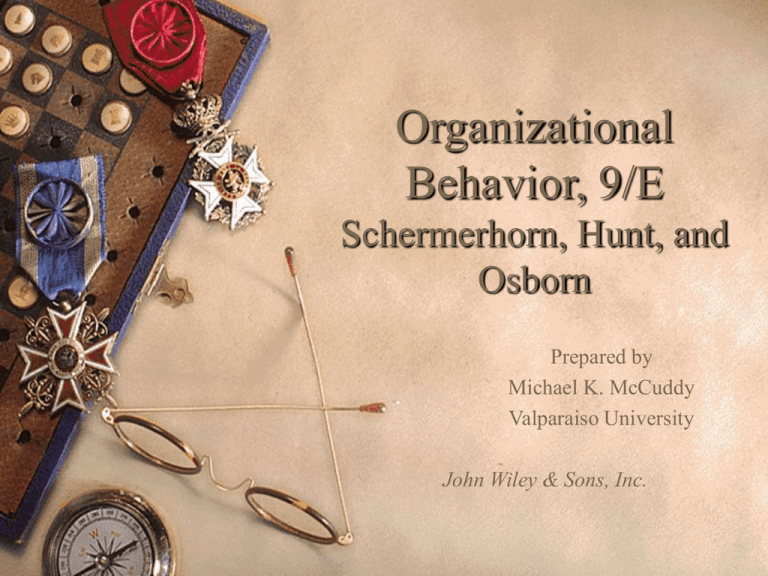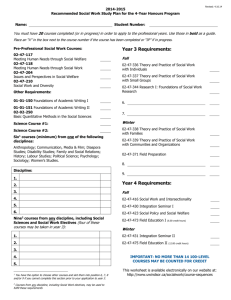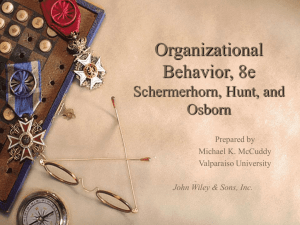
Organizational
Behavior, 9/E
Schermerhorn, Hunt, and
Osborn
Prepared by
Michael K. McCuddy
Valparaiso University
John Wiley & Sons, Inc.
Chapter 9 Study Questions
What is the nature of groups in
organizations?
What are the stages of group development?
What are the foundations of group
performance?
How do groups make decisions?
Organizational Behavior: Chapter 9
2
Study Question 1: What is the nature
of groups in organizations?
A group is a collection of two or more
people who work with one another
regularly to achieve common goals.
In a true group, members are mutually
dependent on one another and interact with
one another.
Hot groups thrive in conditions of crisis
and competition.
Organizational Behavior: Chapter 9
3
Study Question 1: What is the nature
of groups in organizations?
Effective groups achieve high levels of:
– Task performance.
• Members attain performance goals regarding quantity,
quality, and timeliness of work results.
– Members satisfaction.
• Members believe that their participation and experiences are
positive and meet important personal needs.
– Team viability.
• Members are sufficiently satisfied to continue working
together on an ongoing basis.
Organizational Behavior: Chapter 9
4
Study Question 1: What is the nature
of groups in organizations?
How groups help organizations
– Groups are good for people.
– Groups can improve creativity.
– Groups can make better decisions.
– Groups can increase commitments to action.
– Groups help control their members.
– Groups help offset large organization size.
Organizational Behavior: Chapter 9
5
Study Question 1: What is the nature
of groups in organizations?
Situations in which groups are superior to
individuals.
– When there is no clear expert in a particular
problem or task.
– When problem solving can be handled by a
division of labor and the sharing of
information.
– When creativity and innovation are needed.
Organizational Behavior: Chapter 9
6
Study Question 1: What is the nature
of groups in organizations?
Potential benefits for group members.
– People learn from each other and share job skills and
knowledge.
– Groups are important sources of need satisfaction for
their members.
– Members can provide emotional support for each
other in times of crisis or pressure.
– Members’ contributions can help them experience
self-esteem and personal involvement.
Organizational Behavior: Chapter 9
7
Study Question 1: What is the nature
of groups in organizations?
Social loafing.
– The tendency of people to work less hard in a
group than they would individually.
– Reasons for social loafing.
• Individual contributions are less noticeable in the
group context.
• Some individuals prefer to see others carry the
workload.
Organizational Behavior: Chapter 9
8
Study Question 1: What is the nature
of groups in organizations?
Ways of preventing social loafing.
– Define member roles and tasks to maximize
individual interests.
– Raise accountability by identifying
individuals’ performance contributions to the
group.
– Link individual rewards to performance
contributions to the group.
Organizational Behavior: Chapter 9
9
Study Question 1: What is the nature
of groups in organizations?
Social facilitation.
– The tendency for a person’s behavior to be
influenced by the presence of others.
– Positively affects performance when a person
is proficient on the task.
– Negatively affects task performance when the
task is not well-learned.
Organizational Behavior: Chapter 9
10
Study Question 1: What is the nature
of groups in organizations?
Formal groups.
– Officially designated to serve a specific
organizational purpose.
– The head of a formal group is responsible for
the group’s performance and serves a “linkingpin” role.
– May be permanent or temporary.
• Permanent work groups are command
groups.
• Temporary work groups are task groups.
Organizational Behavior: Chapter 9
11
Study Question 1: What is the nature
of groups in organizations?
Types of formal groups.
– Cross-functional teams or task forces.
• Engage in special problem-solving efforts
drawing on input of the functional areas.
– Project teams.
• Formed to complete a specific task with a
well-defined end point.
– Virtual group.
• Members work together via computers.
Organizational Behavior: Chapter 9
12
Study Question 1: What is the nature
of groups in organizations?
Informal groups.
– Emerge without being officially designated by
the organization.
– Types of informal groups.
• Friendship groups.
• Interest groups.
Organizational Behavior: Chapter 9
13
Study Question 1: What is the nature
of groups in organizations?
Effects of informal groups.
– Can help people get their jobs done.
– Can speed up workflow by supplementing
formal lines of authority.
– Can satisfy needs that are thwarted or unmet
by the formal group.
– Can provide members with social satisfaction,
security, and a sense of belonging.
Organizational Behavior: Chapter 9
14
Study Question 2: What are the
stages of group development?
Organizational Behavior: Chapter 9
15
Study Question 2: What are the
stages of group development?
Forming stage.
– Initial entry of members to a group.
– Member challenges.
• Getting to know each other.
• Discovering what is considered acceptable
behavior.
• Determining the group’s real task.
• Defining group rules.
Organizational Behavior: Chapter 9
16
Study Question 2: What are the
stages of group development?
Storming stage.
– A period of high emotionality and tension
among group members.
– Member challenges.
•
•
•
•
•
•
Hostility and infighting.
Formation of coalitions and cliques.
Clarification of members’ expectations.
Giving attention to obstacles to group goals.
Understanding one another’s interpersonal styles.
Finding ways to accomplish group goals while
satisfying individual needs.
Organizational Behavior: Chapter 9
17
Study Question 2: What are the
stages of group development?
Norming stage.
– The point at which the group really begins to
come together as a coordinated unit.
– Member challenges.
• Holding group together by maintaining a positive
balance.
• Letting the desire for group harmony obscure
group problems.
• Being mistaken about reaching ultimate maturity .
Organizational Behavior: Chapter 9
18
Study Question 2: What are the
stages of group development?
Performing stage.
– Marks the emergence of a mature, organized,
and well-functioning group.
– Member challenges.
• Meeting complex tasks and conflicts in creative
ways.
• Being motivated by group goals and achieving
satisfaction.
• Continuing to improve relationships and
performance.
• Adapting to changing opportunities and demands.
Organizational Behavior: Chapter 9
19
Study Question 2: What are the
stages of group development?
Organizational Behavior: Chapter 9
20
Study Question 2: What are the
stages of group development?
Adjourning stage.
– A well-integrated group is:
• Able to disband when its work is finished.
• Willing to work together in the future.
– Particularly important for temporary groups.
Organizational Behavior: Chapter 9
21
Study Question 3: What are the
foundations of group performance?
Organizational Behavior: Chapter 9
22
Study Question 3: What are the
foundations of group performance?
Tasks.
– Technical demands of a task.
• Routineness, difficulty, and information
requirements.
– Tasks that are complex in technical demands
require unique solutions and more information
processing.
Organizational Behavior: Chapter 9
23
Study Question 3: What are the
foundations of group performance?
Tasks (cont.).
– Social demands of a task.
• Relations, ego involvement, and controversies over
ends and means.
– Tasks that are complex in social demands
involve difficulties in reaching agreement on
goals or methods for accomplishing them.
Organizational Behavior: Chapter 9
24
Study Question 3: What are the
foundations of group performance?
Goals, rewards, and resources.
– Long-term performance relies on:
• Appropriate goals.
• Well-designed reward systems.
• Adequate resources.
– A group’s performance can suffer when:
• Goals are unclear, unchallenging, or arbitrarily imposed.
• Goals are focused too much on individuals.
• Adequate budgets, facilities, good work methods and
procedures, and the best technologies are not available.
Organizational Behavior: Chapter 9
25
Study Question 3: What are the
foundations of group performance?
Technology.
– Provides the means to get work accomplished.
– The right technology must be available for the
task at hand.
– Workflow technology can affect the way
group members interact.
Organizational Behavior: Chapter 9
26
Study Question 3: What are the
foundations of group performance?
Membership characteristics.
– A group must have the right skills and
competencies available for task performance
and problem solving.
• Homogeneous groups may not perform well if they
lack the requisite experiences, skills, and
competencies.
• Heterogeneous groups may perform well if they
effectively utilize a variety of experiences, skills,
and competencies.
Organizational Behavior: Chapter 9
27
Study Question 3: What are the
foundations of group performance?
Membership characteristics (cont.).
– Diversity-consensus dilemma.
• Increasing diversity among group members makes
it harder for group members to work together, even
though the diversity itself expands the skills and
perspectives available for problem solving.
Organizational Behavior: Chapter 9
28
Study Question 3: What are the
foundations of group performance?
Membership characteristics (cont.).
– FIRO-B theory.
• Identifies individual differences in how people
relate to one another in groups.
• Based on needs to express and receive feelings of
inclusion, control, and affection.
• Groups whose members have compatible
characteristics are likely to be more effective.
• Groups whose members have incompatible
characteristics are likely to be less effective.
Organizational Behavior: Chapter 9
29
Study Question 3: What are the
foundations of group performance?
Membership characteristics (cont.).
– Status.
• A person’s relative rank, prestige, or standing in a
group.
– Status congruence.
• Occurs when a person’s position within the group
is equivalent in status to positions held outside the
group.
• When status incongruence is present, problems will
likely occur.
Organizational Behavior: Chapter 9
30
Study Question 3: What are the
foundations of group performance?
Group size.
– Can make a difference in a group’s
effectiveness.
– As group size increases, performance and
member satisfaction increase up to a point.
– As a group size continues to grow,
communication and coordination problems
often set in, and performance and satisfaction
may decline.
– Problem-solving groups should have 5 to 7
members.
Organizational Behavior: Chapter 9
31
Study Question 3: What are the
foundations of group performance?
Group dynamics concern the forces
operating within groups that affect the way
members relate to and work with one
another.
From a systems perspective, the
throughputs for a group or team are group
dynamics.
Organizational Behavior: Chapter 9
32
Study Question 3: What are the
foundations of group performance?
What goes on within groups.
– Work group behaviors.
• Required behaviors — those that are formally
defined and expected by the organization.
• Emergent behaviors — those that group members
display in addition to what the organization asks of
them.
Organizational Behavior: Chapter 9
33
Study Question 3: What are the
foundations of group performance?
What goes on within groups.
– Member relationships.
• Activities — the things people do or the actions
they take.
• Interactions — interpersonal communications and
contacts.
• Sentiments — the feelings, attitudes, beliefs, or
values held by group members.
Organizational Behavior: Chapter 9
34
Study Question 3: What are the
foundations of group performance?
What goes on between groups.
– Intergroup dynamics.
• The dynamics that take place between two or more
groups.
– Ways to achieve positive intergroup dynamics.
• Refocusing members on a common enemy or goal.
• Negotiating directly.
• Training members to work more cooperatively.
• Refocusing rewards on contributions to the total
organization and how much groups help each other.
Organizational Behavior: Chapter 9
35
Study Question 3: What are the foundations of
group performance?
Organizational Behavior: Chapter 9
36
Study Question 4: How do groups
make decisions?
How groups make decisions.
– Decision by lack of response.
• One idea after another is suggested without any discussion-
taking place; when the group finally accepts the idea, all
others have been bypassed and discarded by simple lack of
response rather than by critical evaluation.
– Decision by authority rule.
• The chairperson, manager, or leader makes a decision for the
group.
– Decision by minority rule.
• Two or three people are able to dominate or “railroad” the
group into making a decision to which they agree.
Organizational Behavior: Chapter 9
37
Study Question 4: How do groups
make decisions?
How groups make decisions (cont.).
– Decision by majority rule.
• Formal voting may take place, or members may be polled to
find the majority viewpoint.
– Decision by consensus.
• Discussion leads to one alternative being favored by most
members and the other members agree to support it.
– Decision by unanimity.
• All group members agree totally on the course of action to be
taken.
Organizational Behavior: Chapter 9
38
Study Question 4: How do groups
make decisions?
Potential advantages of group decision
making.
– More knowledge and expertise is applied to
solve the problem.
– A greater number of alternatives are examined.
– The final decision is better understood and
accepted by all group members.
– More commitment among all group members
to make the final decision work.
Organizational Behavior: Chapter 9
39
Study Question 4: How do groups
make decisions?
Potential disadvantages of group decision
making.
– Individuals may feel compelled to conform to
the apparent wishes of the group.
– The group’s decision may be dominated by
one individual or a small coalition.
– Group decisions usually take longer to make.
Organizational Behavior: Chapter 9
40
Study Question 4: How do groups
make decisions?
Ways to avoid groupthink.
– Assign the role of critical evaluator to each
group member.
– Have the leader avoid seeming partial to one
course of action.
– Create subgroups that each work on the same
problem.
– Have group members discuss issues with
outsiders and report back.
Organizational Behavior: Chapter 9
41
Study Question 4: How do groups
make decisions?
Ways to avoid groupthink (cont.).
– Invite outside experts to observe and react to
group processes.
– Assign someone to be a “devil’s advocate” at
each meeting.
– Write alternative scenarios for the intentions of
competing groups.
– Hold “second-chance” meetings after
consensus is apparently achieved.
Organizational Behavior: Chapter 9
42
Study Question 4: How do groups
make decisions?
How to improve group decisions.
– Brainstorming.
• Group members actively generate as many ideas
and alternatives as possible, and they do so
relatively quickly and without inhibitions.
– Nominal group technique.
• Puts people in small groups of six to seven
members and asks everyone to respond
individually and in writing to a “nominal”
question.
Organizational Behavior: Chapter 9
43
Study Question 4: How do groups
make decisions?
How to improve group decisions (cont.).
– Delphi technique.
• Involves generating decision-making alternatives
through a series of survey questionnaires.
– Computer-mediated decision making.
• Group decision making takes place across great
distances with the aid of group decision support
systems.
Organizational Behavior: Chapter 9
44
COPYRIGHT
Copyright 2005 © John Wiley & Sons, Inc. All rights reserved.
Reproduction or translation of this work beyond that permitted in Section
117 of the 1976 United States Copyright Act without the express written
permission of the copyright owner is unlawful. Request for further
information should be addressed to the Permissions Department, John Wiley
& Sons, Inc. The purchaser may make back-up copies for his/her own use
only and not for distribution or resale. The Publisher assumes no
responsibility for errors, omissions, or damages, caused by the use of these
programs or from the use of the information contained herein.
Organizational Behavior: Chapter 9
45







